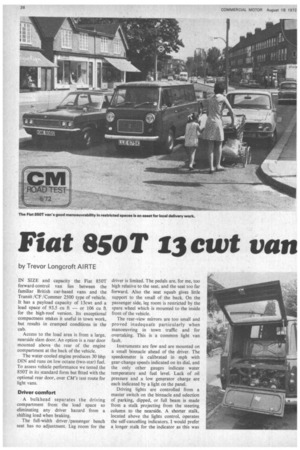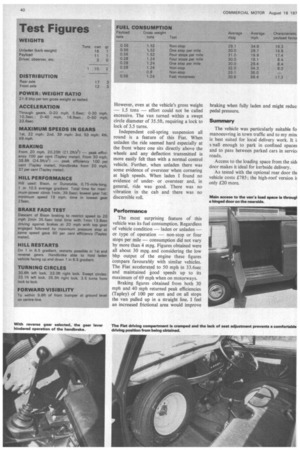Fiat 850T 13cut van
Page 40

Page 41

Page 42

If you've noticed an error in this article please click here to report it so we can fix it.
by Trevor Longeroft Al RTE
IN SIZE and capacity the Fiat 850T forward-control van lies between the familiar British car-based vans and the Transit /CF /Commer 2500 type of vehicle. It has a payload capacity of 13cwt and a load space of 93.5 cu ft — or 106 cu for the high-roof version. Its exceptional compactness makes it useful in town work, but results in cramped conditions in the cab.
Access to the load area is from a large, nearside slam door. An option is a rear door mounted above the rear of the engine compartment at the back of the vehicle.
The water-cooled engine produces 30 bhp DIN and runs on low octane (two-star) fuel. To assess vehicle performance we tested the 850T in its standard form but fitted with the optional rear door, over CM's test route for light vans.
Driver comfort A bulkhead separates the driving compartment from the load space so eliminating any driver hazard from a shifting load when braking.
The full-width driver/passenger bench seat has no adjustment. Leg room for the driver is limited. The pedals are, for me, too high relative to the seat, and the seat too far forward. Also the seat squab gives little support to the small of the back. On the passenger side, leg room is restricted by the spare wheel which is mounted to the inside front of the vehicle.
The rear-view mirrors are too small and proved inadequate particularly when manoeuvring in town traffic and for overtaking. This is a common light van fault.
Instruments are few and are mounted on a small binnacle ahead of the driver. The speedometer is calibrated in mph with gear-change speeds indicated on its dial, and the only other gauges indicate water temperature and fuel level. Lack of oil pressure and a low generator charge are each indicated by a light on the panel Driving lights are controlled from a master switch on the binnacle and selection of parking, dipped, or full beam is made from a stalk projecting from the steering column to the nearside. A shorter stalk, located above the lights control, operates the self-cancelling indicators. I would prefer a longer stalk for the indicator as this was closer to hand on some occasions I mistakenly used the light-control stalk for the indicator. The choke control, gearlever and handbrake are mounted on the floor to the nearside of the driver. The gearlever is comfortably placed, but when in reverse interfered with the operation of the handbrake. The pedals, apart from being too high, were light to operate; although when fully laden I thought the brake pedal required excessive pressure.
With the engine at the rear and a bulkhead between, engine noise in the driving compartment was minimal — most of it comes from the radiator fan. The heater uses ram air chanelled from the front grille for vehicle air circulation, instead of the more usual electric fan, and proved noisy. The flap controlling airflow into the cab did not seal correctly on the test van and the result was a high-pitched whistling whenever the flap was closed.
Ride and handling Despite the remote gearchange linkage necessary with the rear-engine, rear drive, the conventional forward four-speed gate change was extremely smooth and light to operate. The lever was biased to between third and fourth gears and so a driver is unlikely to select first instead of third when changing up from second. Reverse is obtained by depressing the lever, and pulling across toward the driver, and then to the rear. Throughout the test I rarely selected reverse first time. When engagement was difficult I found the best method was to drive the vehicle forward about 6in. and then attempt the change. Steering when driving unladen was light; as the vehicle was loaded it became progressively heavier. However, even at the vehicle's gross weight 1.5 tons effort could not be called excessive. The van turned within a swept circle diameter of 35.5ft, requiring a lock to lock of 3.5 turns.
Independent coil-spring suspension all round is a feature of this Fiat. When unladen the ride seemed hard especially at the front where one sits directly above the wheels and any deflection transmitted is more easily felt than with a normal control vehicle. Further, when unladen there was some evidence of oversteer when cornering at high speeds. When laden I found no evidence of underor oversteer and, in general, ride was good. There was no vibration in the cab and there was no discernible roll.
Performance The most surprising feature of this vehicle was its fuel consumption. Regardless of vehicle condition laden or unladen or type of operation non-stop or four stops per mile consumption did not vary by more than 4 mpg. Figures obtained were all about 30 mpg. and considering the low bhp output of the engine these figures compare favourably with similar vehicles. The Fiat accelerated to 50 mph in 33.6sec and maintained good speeds up to its maximum of 69 mph when on motorways.
Braking figures obtained from both 30 mph and 40 mph returned peak efficiencies (Tapley) of 100 per cent and on all stops the van pulled up in a straight line. I feel an increased frictional area would improve braking when fully laden and might reduc. pedal pressure.
Summery The vehicle was particularly suitable fo manoeuvring in town traffic and to my min( is best suited for local delivery work. It it snail enough to park in confined spaces and to pass between parked cars in servic4 roads.
Access to the loading space from the sidc door makes it ideal for kerbside delivery.
As tested with the optional rear door tht vehicle costs £785; the high-roof version it only £20 more.


































































































